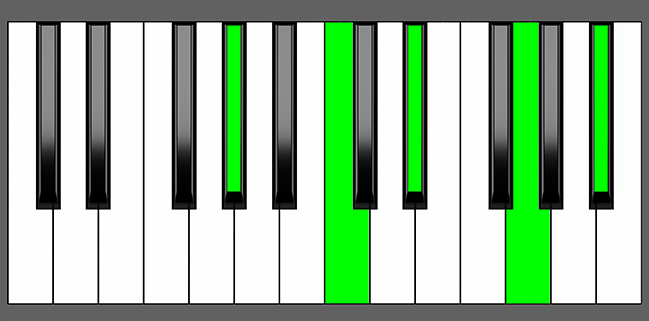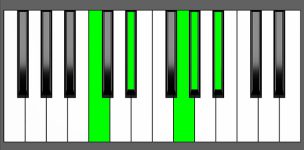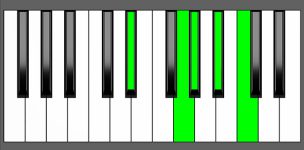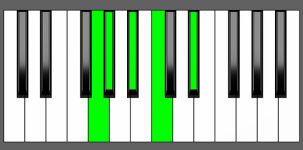Piano Diagram of G# Maj9 in Root Position
A G# Maj9 chord is a type of chord that consists of a major seventh chord combined with a major ninth note. This chord is built upon a G# major scale, and it includes the notes G#, B#, D#, Fx, and A#. Keep reading to get a better grip on the music theory behind this chord.
Structure of G# Maj9
Notes |
|---|
| G#, B#, D#, Fx, A# |
Intervals |
|---|
| R, 3, 5, 7, 9 |
Playing Extended Chords on Piano
Extended chords are commonly used in piano playing, but they can be tricky to play in their entirety due to the large number of notes involved. To make these chords more manageable, pianists often omit certain notes, such as the root or the 5th. Another technique is to split the chord between both hands, playing either full or partial chords in each hand.
However, even when notes are omitted or split between hands, extended chords can still create complex and dense harmonies. When these chords are inverted, the resulting clusters of notes can be particularly challenging to voice effectively.
G# Maj9 Chord Inversions
The G# Maj9 chord has a total of 4 inversions:
| Root Position: | G# | B# | D# | Fx | A# |
| 1st Inversion: | B# | D# | Fx | G# | A# |
| 2nd Inversion: | D# | Fx | G# | A# | B# |
| 3rd Inversion: | Fx | G# | A# | B# | D# |
| 4th Inversion: | A# | B# | D# | Fx | G# |
Piano Keyboard Diagrams
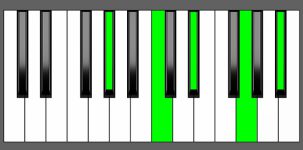
Chord Inversions on Piano
Chord inversions are a fundamental concept in music theory, as they help to understand how chords are constructed and how they can be used in progressions. When discussing chord inversions on a piano keyboard, it is important to note that the diagrams showing the sequence of notes in an inversion may not always correspond to practical playing.
In practical playing, proper chord voicings involve spreading the notes of the chord across different octaves and positions on the keyboard, which may not necessarily match the basic shape of the chord’s inversions as depicted in diagrams. Therefore, while chord inversion diagrams help understand the structure and sequence of notes in a chord, they may not always provide the most efficient way to play the chord on a piano keyboard.
As a pianist, it is important to experiment with different voicings and fingerings of chords to find the most comfortable and efficient way to play them, while still maintaining the intended harmonic function and sound.
Music Theory and Harmony of G# Maj9
Building the G# Maj9 Chord: Different Approaches
Starting from the G# Major Scale
If you want to create a major 7/9 chord, the major scale is a useful reference point. You will need to combine five notes: the Root note, a major 3rd, a 5th interval, a major 7th, and a major 9th.
For instance, to build the G# Maj9 chord, you can start with the G# Major scale.


To form a G# Maj9 chord, use the formula R, 3, 5, 7, 9 as follows:
- Start with the Root note, G#.
- Choose the major 3rd interval, which is B#, and include it in the chord.
- Add the 5th interval, D#.
- Include the major 7th interval, Fx (G).
- Lastly, add the 9th, A#.
By using this straightforward formula, you can produce a major 7/9 chord from any major scale.
by Combining Intervals
To build a major 9th chord, you can use a combination of specific intervals – a major 3rd, a minor 3rd, another major 3rd, and a final minor 3rd.
3 + m3 + 3 + m3 = Major 9th Chords
For instance, we can take the G# Maj9 chord as an example.
When we examine the intervals between the notes in this chord, we can see that:
- G#-B# forms a major 3rd interval,
- B#-D# creates a minor 3rd interval,
- D#-Fx is a major 3rd,
- and finally, Fx-A# forms a minor 3rd interval.
By stacking these five intervals together, we can create the G# Maj9 chord.
by Combining Chords
Another trick to build a Maj9 chord is by combining a major triad with the major chord built on its fifth note.
To create a G# Maj9 chord, for instance, you can combine a G# Major triad (G#, B#, D#) with a D# Major chord (D#, Fx, A#). These two chords share the note D#, and when played together, they form a G# Maj9 chord.
G# Major + D# Major = G# Maj9
How to Use G# Maj9 in a Chord Progression
These tables show the harmonized major and natural minor scales that contain a G# Maj7 chord replaceable with a G# Maj9.
The G# Maj9 chord can be used as the first (I) chord in the G# major scale, and it can also serve as the subdominant chord in the D# major scale. In the natural minor scales, it functions as the third (mediant) chord in the E# natural minor scale and as the sixth (submediant) chord in the B# natural minor scale.
It’s important to keep in mind that all these keys are considered theoretical and not commonly used in practice. This is mainly due to their complex nature, with a high number of accidentals. It’s more convenient to refer to their enharmonic equivalent keys, as they involve fewer accidentals.
on Major Scales
| Major Scales | I | ii | iii | IV | V | vi | vii |
|---|---|---|---|---|---|---|---|
| G# = Ab | AbMaj7 ⇒ AbMaj9 = G# Maj9 | Bb min7 | C min7 | Db Maj7 | Eb7 | F min7 | Gm7b5 |
| D# = Eb | Eb Maj7 | F min7 | G min7 | AbMaj7 ⇒ AbMaj9 = G# Maj9 | Bb7 | C min7 | Dm7b5 |
- Tonic chord in Ab Major as Ab Maj9
- Subdominant chord in Eb Major as Ab Maj9
on Natural minor Scales
| Minor Scales | i | ii | III | iv | v | VI | VII |
|---|---|---|---|---|---|---|---|
| E# = F | F min7 | Gm7b5 | AbMaj7 ⇒ AbMaj9 = G# Maj9 | Bb min7 | C min7 | Db Maj7 | Eb7 |
| B# = C | C min7 | Dm7b5 | EbMaj7 | F min7 | G min7 | AbMaj7 ⇒ AbMaj9 = G# Maj9 | Bb7 |
- Mediant chord in F minor as Ab Maj9
- Submediant chord in C minor as Ab Maj9
G# Maj9 as the Tonic Chord in G# Major
G# Maj9 as Subdominant Chord in D# Major
G# Maj9 as the Mediant Chord in E# Minor
G# Maj9 as the Submediant Chord in B# Minor
Alternative Names for G# Maj9 Chord
- G# ∆9
- G# M9
- G# j7/9
- G# Δ7/9
- G# maj9
- G# Maj9
- G# M7/9
- G# Ma7/9
- G# major7/9
